Re VISITANDO EL ORDEN ZOOMORFO...
39
Summary
Revisiting zoomorphic order:
DECORATIVE DESIGN IN THE LAKE TITICACA
A special kind of wood architecture order for retables and pulpits is developed
around the Lake Titicaca. It is possible, to consider it as a part of a regional itin-
erant aesthetic, i.e., zoomorphic order. Datable between the end of 17th centu-
ry and 18th century, it is one of the stylems that define hybrid baroque, proba-
bly inspired in engraved sources. The above mentioned order already had been
identified and documented 40 years ago by the architects José de Mesa and Te-
resa Gisbert. Nevertheless, to think again about this topic can throw new light
to what was already said, extending certain aspects. I especially want to lead to
the end one of their hypotheses: This column is also a mannerist survival since
it is inspired by treatise writers, so Palladio in his book ‘Quarter of Architecture’
treats Nerva’s temple, on chapter VIII, showing a capital with horses, and Sagre-
do has a capital with heads of sheeps. This conjecture is founded on the traffic
of architecture treatises, but especially on the idea of inspiration and not a faith-
ful reproduction of the engraving sources, since there was only a few holders of
those books. On the other hand, it was more possible to have copies in diverse
degrees due to their transformations because of transposition process. With that
idea, I allow myself to advance on the topic from a new perspective. It is to con-
sider the contribution of a contemporary referrer, already well known and with
a great influence in continental Europe in the beginning of the development of
these hybrid works: Jean Bérain the Elder (1640-1711). In his repertoire, we
find his proposals on variants of capitals of columns and pilasters. Here the ar-
abesque subordinates the acanthus and there is a wide development of fantastic
animals or semihuman beings of a classic mythological character - that shows
us an evident mannerist influence. I will focus on the research of this order, in
two cases: gospel altarpiece in Pomata’s transept and Yunguyo’s major altar and
pulpit, two Dominican churches in the former colonial Chucuito in Peru.
Streszczenie
Reinterpretacja „porządku zoomorficznego”:
MOTYWY DEKORACYJNE W OKOLICACH JEZIORA TITICACA
W wyposażeniu wnętrz kościołów okolic jeziora Titicaca wśród drewnianych
elementów architektonicznych, zwłaszcza w realizacjach ołtarzy czy ambon, na-
potkamy specyficzny „porządek zoomorficzny”, kategorię, którą można uznać
za część lokalnej estetyki. Rozwój tego typu elementów dekoracyjnych przy-
pada na koniec wieku XVII i wiek XVIII, a opisane tu detale są jednymi z bar-
dziej charakterystycznych elementów stylistyki mestizo typowej dla pewnych
regionów peruwiańskiego baroku. Analizując wzory graficzne, łatwo możemy
39
Summary
Revisiting zoomorphic order:
DECORATIVE DESIGN IN THE LAKE TITICACA
A special kind of wood architecture order for retables and pulpits is developed
around the Lake Titicaca. It is possible, to consider it as a part of a regional itin-
erant aesthetic, i.e., zoomorphic order. Datable between the end of 17th centu-
ry and 18th century, it is one of the stylems that define hybrid baroque, proba-
bly inspired in engraved sources. The above mentioned order already had been
identified and documented 40 years ago by the architects José de Mesa and Te-
resa Gisbert. Nevertheless, to think again about this topic can throw new light
to what was already said, extending certain aspects. I especially want to lead to
the end one of their hypotheses: This column is also a mannerist survival since
it is inspired by treatise writers, so Palladio in his book ‘Quarter of Architecture’
treats Nerva’s temple, on chapter VIII, showing a capital with horses, and Sagre-
do has a capital with heads of sheeps. This conjecture is founded on the traffic
of architecture treatises, but especially on the idea of inspiration and not a faith-
ful reproduction of the engraving sources, since there was only a few holders of
those books. On the other hand, it was more possible to have copies in diverse
degrees due to their transformations because of transposition process. With that
idea, I allow myself to advance on the topic from a new perspective. It is to con-
sider the contribution of a contemporary referrer, already well known and with
a great influence in continental Europe in the beginning of the development of
these hybrid works: Jean Bérain the Elder (1640-1711). In his repertoire, we
find his proposals on variants of capitals of columns and pilasters. Here the ar-
abesque subordinates the acanthus and there is a wide development of fantastic
animals or semihuman beings of a classic mythological character - that shows
us an evident mannerist influence. I will focus on the research of this order, in
two cases: gospel altarpiece in Pomata’s transept and Yunguyo’s major altar and
pulpit, two Dominican churches in the former colonial Chucuito in Peru.
Streszczenie
Reinterpretacja „porządku zoomorficznego”:
MOTYWY DEKORACYJNE W OKOLICACH JEZIORA TITICACA
W wyposażeniu wnętrz kościołów okolic jeziora Titicaca wśród drewnianych
elementów architektonicznych, zwłaszcza w realizacjach ołtarzy czy ambon, na-
potkamy specyficzny „porządek zoomorficzny”, kategorię, którą można uznać
za część lokalnej estetyki. Rozwój tego typu elementów dekoracyjnych przy-
pada na koniec wieku XVII i wiek XVIII, a opisane tu detale są jednymi z bar-
dziej charakterystycznych elementów stylistyki mestizo typowej dla pewnych
regionów peruwiańskiego baroku. Analizując wzory graficzne, łatwo możemy




